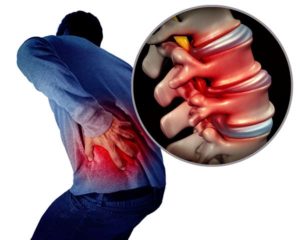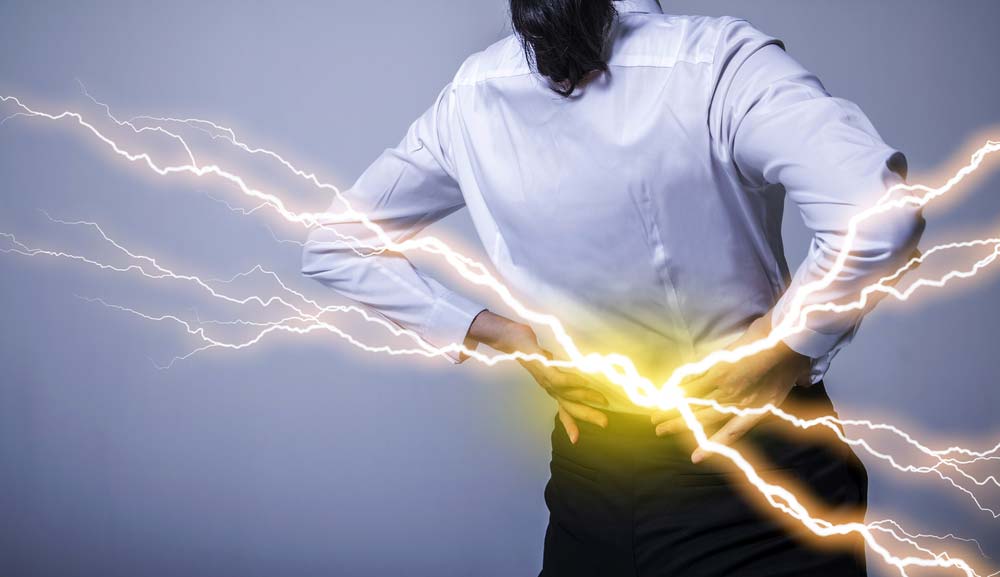Low back pain is mainly localised in the lumbar region. However, the patient can also refer pain in other nearby areas. There are multiple medical conditions that can cause low back pain. In many cases, it has a multifactorial origin, which means it can be a consequence of multiple factors.
Most of the time (90%) responds to vertebral and paravertebral causes, being difficult to identify with accuracy the original cause. 10% of them become chronic and can cause significant personal, family, work and economic repercussions.
In 80% of the cases, the findings are nonspecific and only in 20% of the cases the etiological cause can be determined; of these between 3 and 5% present a serious underlying pathology.
Medical conditions can cause back pain
The following list describes the causes of back pain:
Mechanical lumbago
 Impaired vertebral static (scoliosis), muscle contractures (due to mechanical or tension overload), degenerative problems of the intervertebral disc or vertebral posterior joints, osteoporosis fractures or violent trauma.
Impaired vertebral static (scoliosis), muscle contractures (due to mechanical or tension overload), degenerative problems of the intervertebral disc or vertebral posterior joints, osteoporosis fractures or violent trauma.
Sciatica
The sciatic nerve has its origin in the spinal cord and goes down through the hips and buttocks until it branches off the legs. This nerve controls the muscles in the back of the knee and is responsible for the sensitivity of some parts of the thigh, the lower leg region and the sole of the foot.
When it suffers damage or is pressed, pain and alterations in muscle functions and the sensitivity of these areas occur. The main causes that can damage the sciatic nerve are:
-Herniated disc.
-Fracture or pelvic injury.
-Spinal stenosis.
-Pyriform syndrome.
-Tumours.
-Paget’s disease.
-Pregnancy.
Non-mechanical low back pain
Other less frequent causes are inflammatory diseases of the vertebral structures (such as ankylosing spondylitis); infections or tumours.
Infections
Essentially they are going to be pyogenic infections, they can also be tuberculous and, more rarely, fungal. Among the pyogens:
-Golden staphylococcus, which occurs in half of these cases. It is common in parenteral drug addicts.
-Staphylococcus epidermidis, which is usually secondary to surgical interventions or vertebral punctures.
-Streptococcus is associated with the concomitant presence of endocarditis.
-Gram negative bacilli appear in 25 or 30 percent of cases, mainly Escherichia coli. In this case, there is usually a history of urinary infection.
Tumours
In the tumour condition, multiple myeloma and bone metastases are mainly due to breast, prostate, lung, kidney, thyroid and digestive cancers, in that order.
Other causes:
-Endocrine and metabolic diseases.
-Haematological diseases.
-Miscellaneous: Paget’s disease, vertebral sarcoidosis, Charcot disease, and hereditary diseases.
Special considerations
There are some considerations to keep in mind:
1) In most patients with low back pain, there is no structural alteration that justifies it.
2) Most are self-limited in time and of benign course.
3) Diagnostic scans sometimes produce little benefit, the description of the pain reported by the patient and its location is sometimes more valuable for the diagnosis.
The London Spine Unit will be able to investigate the cause of your back pain and provide the best solutions. Book an appointment to get a doctor’s checkup.
Additional Link
- Comparison of Percutaneous Endoscopic Surgery and Traditional Anterior Open Surgery for Treating Lumbar Infectious Spondylitis.
- How is Laser Disc Surgery Performed?
- Back Pain Specialist London
- A study of the relationship among fear-avoidance beliefs, pain and disability index in patients with low back pain.

